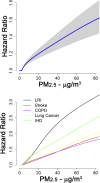Global estimates of mortality associated with long-term exposure to outdoor fine particulate matter
- PMID: 30181279
- PMCID: PMC6156628
- DOI: 10.1073/pnas.1803222115
Global estimates of mortality associated with long-term exposure to outdoor fine particulate matter
Abstract
Exposure to ambient fine particulate matter (PM2.5) is a major global health concern. Quantitative estimates of attributable mortality are based on disease-specific hazard ratio models that incorporate risk information from multiple PM2.5 sources (outdoor and indoor air pollution from use of solid fuels and secondhand and active smoking), requiring assumptions about equivalent exposure and toxicity. We relax these contentious assumptions by constructing a PM2.5-mortality hazard ratio function based only on cohort studies of outdoor air pollution that covers the global exposure range. We modeled the shape of the association between PM2.5 and nonaccidental mortality using data from 41 cohorts from 16 countries-the Global Exposure Mortality Model (GEMM). We then constructed GEMMs for five specific causes of death examined by the global burden of disease (GBD). The GEMM predicts 8.9 million [95% confidence interval (CI): 7.5-10.3] deaths in 2015, a figure 30% larger than that predicted by the sum of deaths among the five specific causes (6.9; 95% CI: 4.9-8.5) and 120% larger than the risk function used in the GBD (4.0; 95% CI: 3.3-4.8). Differences between the GEMM and GBD risk functions are larger for a 20% reduction in concentrations, with the GEMM predicting 220% higher excess deaths. These results suggest that PM2.5 exposure may be related to additional causes of death than the five considered by the GBD and that incorporation of risk information from other, nonoutdoor, particle sources leads to underestimation of disease burden, especially at higher concentrations.
Keywords: concentration; exposure; fine particulate matter; mortality; risk.
Copyright © 2018 the Author(s). Published by PNAS.
Conflict of interest statement
Conflict of interest statement: J.V.S. is an independent consultant and not benefiting commercially from the results of this research.
Figures


Comment in
-
Short-term health co-benefits of existing climate policies: the need for more ambitious and integrated policy action.Lancet Planet Health. 2023 Jul;7(7):e540-e541. doi: 10.1016/S2542-5196(23)00126-2. Lancet Planet Health. 2023. PMID: 37437994 No abstract available.
References
-
- GBD 2015 Risk Factors Collaborators Global, regional, and national comparative risk assessment of 79 behavioural, environmental and occupational, and metabolic risks or clusters of risks, 1990–2015: A systematic analysis for the global burden of disease study 2015. Lancet. 2016;388:1659–1724. - PMC - PubMed
-
- Cox DR. Regression models and life-tables. J R Stat Soc B. 1972;34:187–220.
-
- World Health Organization 2014 Mortality and burden of disease from ambient air pollution: Situation and trends. Available at www.who.int/gho/phe/outdoor_air_pollution/burden_text/en/. Accessed January 14, 2018.
MeSH terms
Substances
Grants and funding
LinkOut - more resources
Full Text Sources
Other Literature Sources
Medical

